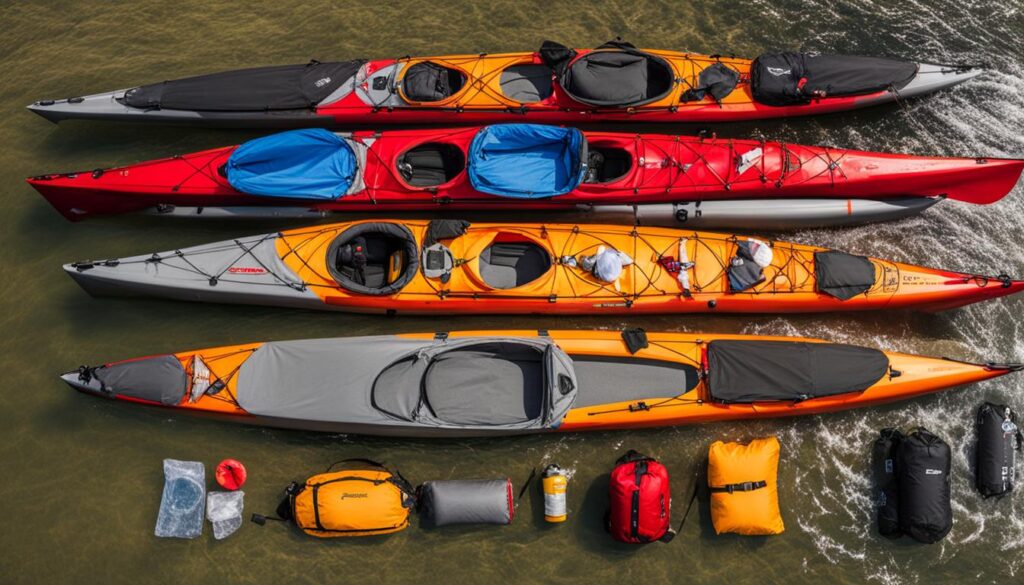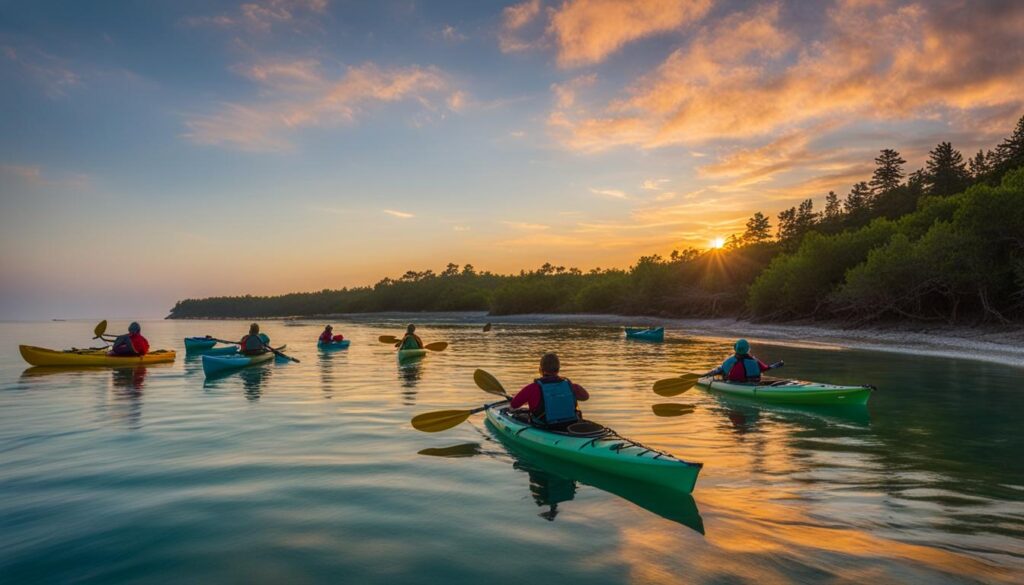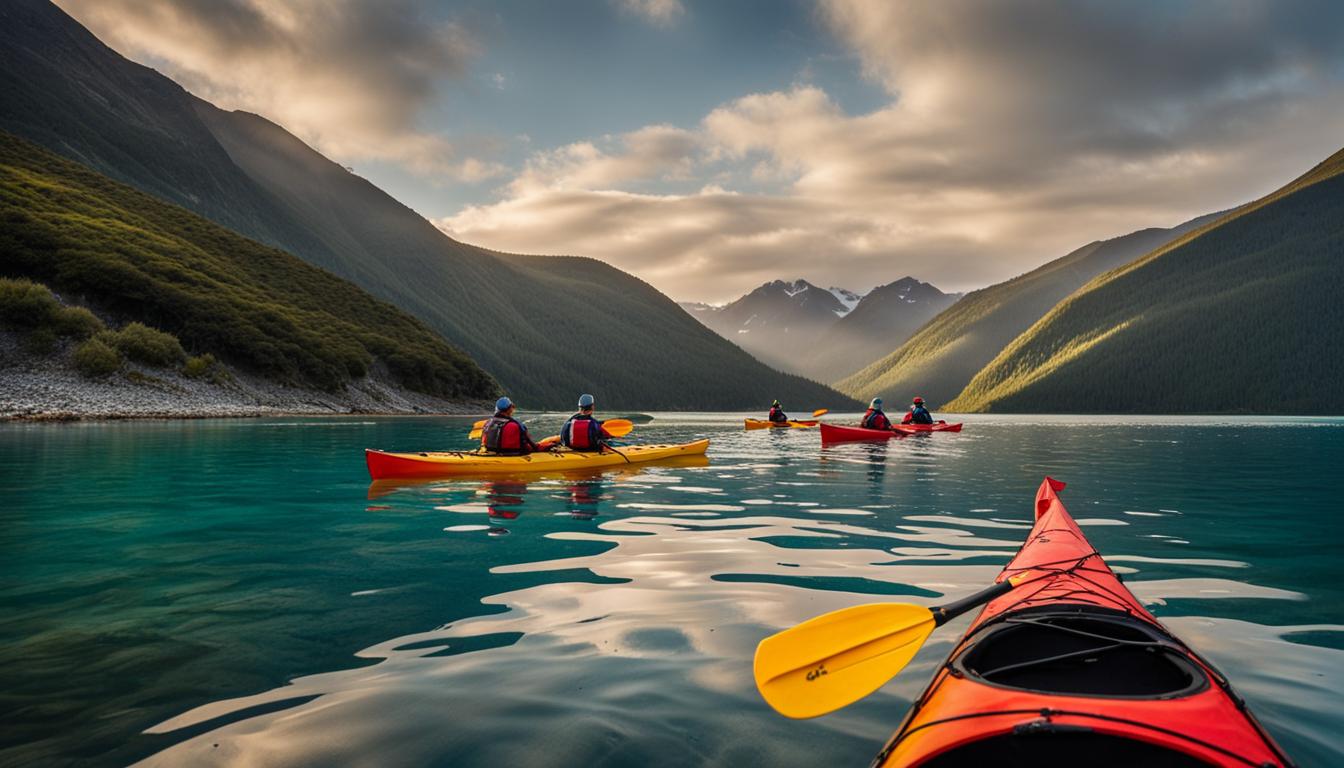Planning a multi-day sea kayaking trip can be an exhilarating experience that allows you to explore the beauty of nature while enjoying the thrill of adventure. Whether you’re a seasoned kayaker or a beginner, taking the time to plan your trip properly is essential for a safe and enjoyable experience.
When planning your multi-day kayak adventure, it’s important to consider factors such as the location, route, and safety precautions. From choosing the right gear to mapping out your journey, every detail plays a crucial role in ensuring a successful trip.
In this article, we will provide you with a comprehensive guide on planning and enjoying multi-day sea kayaking trips. We’ll cover everything from choosing the right kayak and equipment to packing essentials and clothing recommendations. Additionally, we’ll share valuable tips on route planning, safety precautions, and paddling techniques.
So, whether you’re dreaming of a serene kayaking trip or an adrenaline-filled adventure, this article has got you covered. Get ready to embark on a journey filled with breathtaking landscapes, peaceful waters, and unforgettable memories.
Key Takeaways:
- Proper planning is crucial for a successful multi-day sea kayaking trip.
- Choosing the right equipment, including a suitable sea kayak, is essential.
- Packing essentials and choosing the right clothing are important for comfort and safety.
- Route planning, safety precautions, and paddling techniques play a significant role in a successful trip.
- Remember to prioritize safety and enjoy the adventure!
Choosing the Right Sea Kayak and Equipment
When embarking on a multi-day sea kayaking trip, selecting the right equipment is crucial for a safe and enjoyable adventure. Your choice of sea kayak will significantly impact your journey, so it’s essential to consider several factors before making a decision.
The first consideration is the length of the kayak. Longer kayaks provide better tracking and speed, making them ideal for covering long distances. On the other hand, shorter kayaks offer increased maneuverability, which is necessary for navigating narrow waterways and rocky shorelines.
In addition to length, the material of the kayak is another important consideration. Fiberglass kayaks are lightweight and provide excellent performance, but they can be more prone to damage. Plastic kayaks, on the other hand, are more durable and can withstand rough conditions but may sacrifice some speed and maneuverability.
Once you’ve chosen the right sea kayak, it’s crucial to have the necessary equipment for a safe journey. This includes a paddle, personal flotation device (PFD), spray skirt, and waterproof bags for storing your gear. A reliable paddle is essential for efficient propulsion, while a PFD ensures your safety in case of capsizing. A spray skirt will keep water out of the cockpit, and waterproof bags will protect your belongings from getting wet.
Remember, choosing the right sea kayak and having the essential equipment will significantly enhance your multi-day sea kayaking experience. It’s important to invest time and research into making the right choices, ensuring a safe and enjoyable journey.

Table: Types of Sea Kayaks
| Material | Pros | Cons |
|---|---|---|
| Fiberglass | Lightweight, excellent performance | Prone to damage |
| Plastic | Durable, can withstand rough conditions | Less speed and maneuverability |
Table: Essential Kayaking Equipment
| Equipment | Description |
|---|---|
| Paddle | Provides propulsion and steering |
| Personal Flotation Device (PFD) | Ensures safety in case of capsizing |
| Spray Skirt | Keeps water out of the cockpit |
| Waterproof Bags | Protects gear from getting wet |
Planning Your Route and Safety Precautions
When embarking on a multi-day sea kayaking adventure, proper route planning and safety precautions are essential. By carefully mapping out your route and taking necessary safety measures, you can ensure a smooth and enjoyable journey. Here are some valuable tips and advice to help you plan your route and stay safe during your extended kayak trip.
Route Planning
Before setting off on your multi-day kayaking adventure, it’s important to plan your route thoroughly. Consider the distance you want to cover each day, the potential weather conditions, and the locations where you can camp overnight. Take into account the difficulty level of the route and your own skill level as a kayaker. Research the waterways and consult local resources to gather information about potential hazards, tidal currents, and other factors that may affect your journey. By having a well-planned route, you’ll have a clear direction and peace of mind as you navigate through the waters.
Safety Precautions
When venturing out on a multi-day sea kayaking trip, it’s crucial to prioritize safety. Here are some important safety precautions to follow:
- Check the weather forecast before heading out and be aware of any significant changes that may occur during your trip.
- Share your float plan with someone who is not on the trip, providing details about your intended route, estimated time of arrival, and emergency contact information.
- Carry essential safety equipment, including a personal flotation device (PFD), a whistle or signaling device, a marine VHF radio or a waterproof cellphone, and a first aid kit.
- Be mindful of sea traffic and give way to larger vessels. Stay visible by displaying a navigation light or wearing bright colored clothing.
- Practice self-rescue techniques and be prepared for capsize situations. Know how to re-enter your kayak and how to rescue others if needed.
By following these safety precautions and preparing for potential challenges, you can minimize risks and ensure a safe and enjoyable multi-day sea kayaking experience.
Emergency Preparedness
While we hope that nothing goes wrong during your multi-day kayaking trip, it’s important to be prepared for emergencies. Here are some tips to enhance your emergency preparedness:
- Carry a spare paddle in case your primary paddle gets lost or damaged.
- Pack a repair kit with essential tools and materials to fix minor equipment issues that may arise.
- Be aware of the locations of emergency services and potential bail-out points along your route.
- Check the availability of fresh water along the route, and carry enough drinking water to sustain yourself.
- Stay updated on local regulations and restrictions, and respect the environment by leaving no trace behind.
By taking these precautions and ensuring your emergency preparedness, you can confidently embark on your multi-day sea kayaking adventure, knowing that you are well-equipped to handle any unforeseen circumstances.
Packing and Clothing Essentials
When preparing for several days of kayaking, it’s essential to pack the right gear and clothing to ensure your comfort and safety on the water. Here is a comprehensive packing list to help you prepare for your multi-day kayaking adventure:
Gear Essentials:
- Kayak: Choose a suitable sea kayak based on your experience level and the type of water you’ll be paddling.
- Paddle: Opt for a lightweight and durable paddle that suits your paddling style.
- Personal Flotation Device (PFD): Ensure you have a well-fitted and Coast Guard-approved PFD.
- Spray Skirt: Keep yourself dry by using a spray skirt that fits snugly around the cockpit.
- Navigation Tools: Pack a compass, nautical charts, and a GPS device to navigate the waters effectively.
- Emergency Equipment: Carry a first aid kit, emergency signaling devices, a knife, and a repair kit for any unforeseen situations.
- Food and Water: Pack lightweight, non-perishable food items and plenty of water to sustain you throughout your journey.
- Communication Devices: Bring a waterproof phone case, a waterproof VHF radio, and extra batteries for emergency communication.
- Power Banks: Keep your electronic devices charged with portable power banks.
Clothing Essentials:
Choosing the right clothing is crucial for your comfort and protection during long hours of paddling. Consider packing the following clothing items:
- Synthetic Underwear: Opt for moisture-wicking and quick-drying underwear to stay comfortable.
- Swim Trunks or Shorts: Wear quick-drying swim trunks or shorts for easy movement and water activities.
- Long Sleeve Shirts: Protect yourself from the sun and chilly winds with lightweight, long-sleeve shirts.
- Wetsuit: If paddling in colder waters, pack a wetsuit or drysuit to stay warm.
- Water Shoes: Wear water shoes with non-slip soles to protect your feet and provide traction on wet surfaces.
- Sun Protection: Don’t forget to bring a wide-brimmed hat, sunglasses with UV protection, and sunscreen to shield yourself from the sun’s harmful rays.
- Rain Gear: Pack a waterproof jacket and pants to stay dry during unexpected rain showers.
By packing the right gear and clothing essentials, you’ll be well-prepared for several days of kayaking and ensure a comfortable and enjoyable experience on the water.
Table: Packing Checklist
| Category | Items |
|---|---|
| Kayak Essentials | Kayak, Paddle, PFD, Spray Skirt, Navigation Tools |
| Emergency Equipment | First Aid Kit, Emergency Signaling Devices, Knife, Repair Kit |
| Food and Water | Non-perishable Food, Water |
| Communication | Waterproof Phone Case, VHF Radio, Batteries |
| Power | Power Banks |
| Clothing | Synthetic Underwear, Swim Trunks/Shorts, Long Sleeve Shirts, Wetsuit, Water Shoes, Sun Protection, Rain Gear |
Loading and Balancing Your Kayak
Properly loading and balancing your kayak is crucial for a safe and enjoyable multi-day sea kayaking trip. By distributing the weight evenly and strategically within your kayak, you can ensure stability and maneuverability on the water. Here are some essential tips and techniques for loading and balancing your kayak:
1. Place Heaviest Items Closest to the Cockpit
When packing your kayak, position the heaviest items, such as water containers and food supplies, closest to the cockpit. This will help maintain the kayak’s balance and prevent it from becoming top-heavy. Distributing the weight towards the center of the kayak will also make it easier to control during paddling and maneuvering.
2. Keep the Deck Clear
A cluttered deck can throw off the balance of your kayak and make it more susceptible to capsizing. Ensure that the deck is clear of any unnecessary items or gear. Instead, stow items securely inside the hatches or use deck bags and bungee cords to secure them. This will keep the center of gravity low and maintain stability.
3. Consider Electronics and Metal Equipment
Electronics and metal equipment, such as GPS devices, cameras, and fishing gear, can interfere with the kayak’s balance if not properly distributed. To minimize any potential imbalance, place these items in areas where they won’t disrupt the kayak’s stability. If needed, experiment with different placements to find the most balanced configuration.
Remember, proper loading and balancing of your kayak will contribute to a smoother and more enjoyable paddling experience. Take the time to organize your gear and distribute the weight effectively for a safe and comfortable multi-day kayaking adventure.
| Item | Location |
|---|---|
| Water containers | Closest to the cockpit |
| Food supplies | Closest to the cockpit |
| Paddle | Inside the cockpit or secured on the deck |
| PFD (Personal Flotation Device) | Strapped to the backrest or secured on the deck |
| Sleeping bag and camping gear | Towards the back of the cockpit |
| Electronics and metal equipment | Strategically placed for balance |
Sea Kayak Paddling Techniques
When embarking on a multi-day sea kayaking adventure, it’s important to master proper paddling techniques to enhance your overall experience. Whether you’re a beginner or an experienced kayaker, here are some valuable tips and techniques to improve your sea kayak paddling skills:
1. Maintain Proper Posture:
Ensuring proper posture while paddling is essential for efficiency and preventing fatigue. Sit upright with your back straight and shoulders relaxed. Engage your core muscles and avoid slouching to maintain stability.
2. Use a Proper Grip:
Hold the paddle with a loose but firm grip, placing one hand on the shaft and the other hand on the grip. Keep your hands shoulder-width apart for better control and power. Practice switching hands periodically to avoid muscle strain.
3. Employ Proper Strokes:
There are different types of strokes to master for different maneuvers. The forward stroke is the most basic and involves dipping the blade fully into the water and pulling it back alongside the kayak. The sweep stroke helps to turn the kayak by sweeping the paddle blade in an arc away from the kayak’s side. Practice these strokes to improve your maneuverability.
4. Utilize Your Core Muscles:
Engaging your core muscles while paddling will help generate power and endurance. Focus on rotating your torso and using your abdominal muscles to generate force with each stroke. This will reduce strain on your arms and make paddling more efficient.
By mastering these sea kayak paddling techniques, you’ll be able to navigate through different water conditions and enjoy a smoother and more enjoyable multi-day kayaking journey.

Safety Precautions and Sea Kayak Fishing Tips
Safety is of utmost importance when embarking on a multi-day sea kayaking trip. To ensure a safe and enjoyable experience, it’s crucial to follow these survival tips for long kayaking trips:
- Check weather conditions: Before heading out, always keep an eye on the weather forecast. Sudden changes in weather can pose risks, so plan your trip accordingly and avoid adverse conditions.
- Be prepared with safety equipment: Carry essential safety equipment such as a spare paddle, throw bag, and bailing equipment. These items can be lifesavers in case of an emergency.
- Avoid crowded sea traffic: When kayaking in popular areas, be mindful of other watercraft. Avoid congested areas and give larger vessels the right of way to ensure your safety.
- Know your limits: Be aware of your skill level and choose a trip that matches your capabilities. Pushing yourself too far beyond your comfort zone can lead to accidents or exhaustion.
If you’re interested in fishing during your sea kayaking trip, here are some tips for fishing from a sea kayak:
- Select the right fishing gear: Opt for lightweight and compact fishing gear that won’t take up too much space in your kayak. Look for rods, reels, and tackle that are specifically designed for kayak fishing.
- Secure your gear: Make sure to secure your fishing gear properly to avoid losing it in the water. Use rod holders or other attachment systems to keep your gear within reach but out of the way while paddling.
- Choose the right fishing spots: Explore areas where fish are known to be abundant, such as rocky coastlines, reefs, or shallow waters. Research local fishing regulations and obtain any necessary permits before casting your line.
- Practice safety while fishing: Always wear your personal flotation device (PFD) when fishing from your kayak. Stay alert and aware of your surroundings, and be cautious when handling sharp objects like hooks and knives.
By following these safety precautions and fishing tips, you can have a rewarding and memorable sea kayaking adventure while ensuring your well-being throughout the journey.
Table: Essential Safety Equipment for Sea Kayaking
| Item | Description |
|---|---|
| Spare Paddle | An extra paddle in case of loss or damage to your primary paddle. |
| Throw Bag | A rope bag that can be thrown to someone or used for self-rescue. |
| Bailing Equipment | A device for removing water from the kayak, such as a bilge pump or sponge. |
| Personal Flotation Device (PFD) | A life jacket that provides buoyancy and keeps you afloat in the water. |
Conclusion
In conclusion, multi-day sea kayaking trips offer thrilling and unforgettable adventures for outdoor enthusiasts. With proper planning, essential gear, and safety precautions, you can enjoy the beauty of the waterways while staying safe and comfortable throughout your journey. Whether you’re a beginner or an experienced kayaker, following the tips and guidelines provided in this article will help ensure a successful multi-day sea kayaking trip. So gear up, plan your route, and get ready to embark on an exciting and rewarding kayaking adventure.
FAQ
What equipment do I need for a multi-day sea kayaking trip?
For a multi-day sea kayaking trip, you will need a suitable sea kayak, a paddle, a personal flotation device (PFD), a spray skirt, and waterproof bags for storage. Other essential gear includes a first aid kit, repair kit, navigation tools, and power banks.
How should I plan my route for a multi-day sea kayaking trip?
When planning your route, consider factors such as distance, difficulty, and the availability of bail-out options. It’s important to create a comprehensive float plan and share it with someone who is not on the trip. Stay aware of changing weather conditions and sea traffic, and let someone know where you will be.
What should I pack for a multi-day sea kayaking trip?
Essential items to pack for a multi-day sea kayaking trip include food, water, a first aid kit, repair kit, navigation tools, and power banks. As for clothing, pack synthetic underwear, swim trunks, long sleeve shirts, a wetsuit, water shoes, and sunglasses to protect yourself from the elements.
How should I load and balance my kayak for a multi-day sea kayaking trip?
To load and balance your kayak properly, place the heaviest items closest to the cockpit and keep the deck free of heavy gear to maintain balance. Consider the distribution of electronics and metal equipment to prevent interference.
What paddling techniques should I learn for a multi-day sea kayaking trip?
It’s essential to learn how to paddle in wind without a rudder or skeg and practice self-rescue techniques in case of emergencies. Improving your sea kayak paddling skills will enhance your overall experience on a multi-day kayaking adventure.
How can I ensure safety during a multi-day sea kayaking trip?
Safety should always be a top priority. Be aware of changing weather conditions, avoid crowded sea traffic, and carry essential safety equipment such as a spare paddle, throw bag, and bailing equipment. If you’re interested in fishing, we will provide tips on selecting the right fishing gear and techniques for fishing from a sea kayak.





